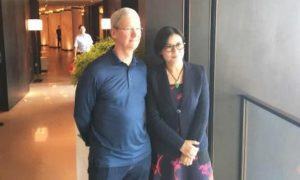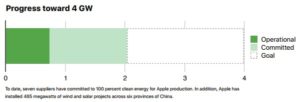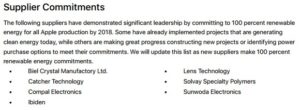Apple Inc. – Powered by 100% Renewable Energy

Apple is committed to shift its production to 100% renewable energy powered. However, they would need to convince the suppliers to shift to renewable energy for Apple product's production, implicating economic impacts. How would they do?
Apple Inc. – Powered by 100% Renewable Energy
“We believe in living in the world better than we found it, and that’s why we’re on track to meet our goal running our entire company on renewable energy”
Tim Cook, Apple CEO
In April 2013 at the The White House Summit on Cybersecurity and Consumer Protection, Tim Cook, Apple’s CEO stated with determined voice that Apple will pursue the goal of running its company 100% by renewable energy [1]. The motive of the determination is widely perceived as Tim Cook’s commitment to lead the tech giant building a more sustainable world [2], while some regard it a response to strengthen Corporate Social Responsibility following public criticism, such as Greenpeace’s report in 2012 “How Clean Is Your Cloud”, criticizing Apple to power its Cloud operation mainly with fossil fuel and nuclear energy [3].
Apple’s determination is not alone, in recent years, 100% renewable energy adoption has become a “fashion” commitment to some of the most influential companies in the world, creating significant Corporate Social Responsibility benefits. There have been 116 companies signed up for the RE100 initiative, aiming at using 100% renewable energy by certain timeframe, including numerous technology companies such as Google, Facebook, Adobe, BT and HP. [4]
However, shifting to 100% renewable energy may not be entirely under Apple’s control. By 2016, manufacturing activities accounted for ~77% of Apple’s comprehensive carbon footprint, in which mostly is from Apple’s suppliers’ production, product usage, transportation and recycling accounted for ~24%, with ~1% from corporate facilities [5]. Pushing suppliers to adopt renewable energy was particularly difficult, given it required additional investment from the suppliers, which likely would transfer to the costs of components. Apple needed to consider carefully how to incentivize its suppliers to adopt renewables without compromising on component costs or quality.
The Clean Energy Program
In October 2015, Apple launched supplier clean energy program to help its manufacturing partners adopt renewables, transiting Apple’s supply chain to 100% clean energy. The goal is to reach 4GW of clean energy collectively by 2020 [6].
The Clean Energy Program recognized three options for suppliers to adopt renewable energy: (1) Self-installation such as solar or wind (2) purchasing power generated by renewables (3) purchasing carbon credits, such as CCER in China. To motivate the suppliers, Apple provided resources to help suppliers understand local market environment, government policies and tools to evaluate economic impacts by different options. In addition, Apple’s executives will visit supplier’s office who commit to adopt renewables, providing public relations and marketing benefits to supplier (Figure 1. & 2.)
Figure 1. Apple’s CEO Tim Cook And Lens Technology CEO Ms. Chou
Figure 2. Apple’s CEO Tim Cook Tweet About Lens Technology’s Commitment To Clean Energy
By April 2017, Apple has installed 485MW of clean energy by itself while 7 suppliers have committed to use renewables for Apple’s product production by 2018.
Figure 3. Apple Supplier Clean Energy Program Update (April 2017)
Future Challenges and Recommendations
Although The Clean Energy Program has demonstrated initial success, the upcoming challenges is expected to be even more difficult. The seven committed manufacturing partners are mainly categorized into three types: (1) Major suppliers which has large sales volume depended on the Apple’s order (2) Suppliers selling commoditized products, e.g. mechanical components. As they are easier to be replaced and are in severe price competition. “Being Green” seemed to be their chance to build competitive advantage (3) Local companies which want to create marketing and brand image. Except these types, suppliers have less incentive to adopt renewable energy and will likely become bottleneck to Apple’s goal.
Figure 4. Committed Manufacturing Partners To Apple Clean Energy Program (April 2017)
In order to attain Apple’s goal of 100% renewable energy, Apples shall consider different approaches providing stronger incentive to suppliers, such as: (1) including renewable energy adoption as one of the supplier selection criteria, on par of product quality and cost (2) investment in renewable energy assets to offset supplier’s non-renewables consumption, either by self-installation, by being shareholder of renewables assets, or by purchasing carbon credits (3) providing financial support to help suppliers overcome initial investment hurdle. This approach can be creative such as loan provided by Apple or other financial partners, or self-support funds provided by Apple’s suppliers network which mostly have existing business relationship already.
Open questions for comment
- What are the major concerns for suppliers to adopt renewable energy?
- What are the solutions to push all of Apple’s suppliers adopt renewable energy?
Note
- Bloomberg, The White House Summit, https://www.youtube.com/watch?v=carwGqGgblc
- Green-Buildings.com Team, Cook Climate Change, https://www.green-buildings.com/articles/tim-cook-climate-change/
- Greenpeace Report 2012 http://www.greenpeace.org/international/Global/international/publications/climate/2012/iCoal/HowCleanisYourCloud.pdf
- RE100 http://there100.org/re100
- Apple Environmental Responsibility Report 2017 https://images.apple.com/environment/pdf/Apple_Environmental_Responsibility_Report_2017.pdf
- Apple Supplier Clean Energy Program Update https://www.apple.com/environment/pdf/Apple_Supplier_Clean_Energy_Program_Update_April_2017.pdf







Thanks for sharing Ray. I enjoyed your perspectives on what Apple should do to ensure that its suppliers adopt similar clean energy initiatives. In particular, given Apple’s significant amount of cash reserves, I think they would be well positioned to execute your recommendation for supplying capital in the form of loans to its manufacturers. I also would imagine that, given Apple’s world-wide supply chain, that shipping and transportation costs will significantly affect their climate impact. Given this dilemma, Apply should take a vested interest in the development of increased emissions regulations in the shipping industry as well as technological advances to measure and decrease emissions in that sector.
Thanks for an insightful essay Ray. I’m intrigued by your question regarding how to motivate suppliers to switch to renewable energy themselves. I think ultimately it comes down to how much purchasing power companies like Apple have with these supplier and the % of revenues that they contribute to these suppliers. Apple could easily throw its weight around to force suppliers to switch to renewables. Although this might lower goodwill in the relationship, I fear that another supplier would jump at the chance to work with Apple if Apple’s current supplier refused to comply!
What I hope to better understand is the interaction between economic benefits and social responsibility. If the such initiative is against companies’ economic benefits, is it really sustainable? For example, if Apple forces its suppliers to use renewable energy, which is more expensive than the traditional energy, the total cost for the entire society shall increase. I still believe it’s crucial to align social responsibility with economic benefits and incremental changes i/o radical ones should be made to achieve this goal.
Great article! This was such a heartening read. Apple’s commitment to 100% renewable energy powered production is as admirable as it is ambitious. Hopefully it will continue to set the industry standard and more companies join suit. To that end, I would like to see Apple use more of a “carrot” than a “stick” approach to getting its suppliers on board.
Financial support, as you mentioned, would certainly go a long way toward helping suppliers take advantage of solar, wind, and other renewable energy sources. Apple can offer investment funds to its suppliers for energy efficient projects such as the installation of solar panels and wind turbines.
Operational support will be required. As the suppliers make the switch to renewables, Apple must operate a flexible and responsive supply chain. Planning and process changes should be expected. Even those that are painful in the short run will likely be worth it for the long term gains from sustainability.
Technological support could also be useful. Apple can offer its suppliers data and analytics to show historical performance metrics, current snapshots of energy use, and future opportunities to improve cost savings and efficiency gains through clean energy.
Very thoughtful and comprehensive article!
I think that the key to transforming Apple’s supply chain will be transparency and flexibility.
Transparency – because, as other mentioned, going green usually is financially disadvantageous in the short term. Therefore it needs to be clear that Apple is happy with increased costs if it improves sustainability, this trade-off needs to be put explicitly into numbers and rules for supplier selection, and finally the commitment needs to be made for the long term.
But transparency is nothing if Apple cannot penalize the non-compliant companies and reward the compliant ones with giving them more or less business on a shorter notice. This – again – can make processes less streamlined and watertight, thus increasing the overall average cost.
In my opinion, Apple’s minimalistic product design, in which suppliers’ brands are not visible to end-customers, is a major challenge on incentivising suppliers to become 100% Powered by Renewal Energy, unless the NPV of such investments in the long-term represent a significant cost reduction opportunity and suppliers have the financial capacity to invest in such renewal energy technologies. In cases where suppliers need financing for such products, I think Apple should refrain to invest its cash on such projects. Alternatively, such projects should look for project-finance funds or partnership with renewal energy providers to design and develop such technologies under a license-agreement directly with suppliers, without Apple’s intermediation.
Thank you for an interesting article. While I applaud Apple’s willingness to engage on such an important issue, I think you raise a key distinction between the “marketing” of being “100% renewable”, and the reality of Apple’s global footprint being anything but. The fact that more than 3/4 of Apple’s carbon footprint arises outside the bounds of Apple’s own facilities speaks to the enormous challenge of truly implementing a renewable/carbon neutral platform; especially given that most of Apple’s production occurs in countries where environmental protections and regulations are far more lax, and far more difficult to enforce, than in the US. Apple does have several levers of power, both of the stick and carrot variety, with the ability to offer financial and technical expertise to help with renewable energy projects for its partners, and the ability to threaten a withdrawal of future contracts for non-compliant suppliers. As it applies these levers, it will need to balance its environmental mission with its need to continue competing in a highly fickle and competitive industry.
Apple’s commitment to producing via 100% renewable energy reflects the type of corporate leadership that consumers should reward. The challenges of climate change are most effectively overcome via bottoms-up approaches / buy-in. Your three proposals are strong recommendations for Apple as it works toward this goal. I found your third proposal (i.e. financial support for suppliers) to be the most compelling and actionable path for Apple to manage its supply chain activities. However, Apple’s materials manufacturers may be taking on significant business risk by accepting such investments. For instance, let’s assume one of Apple’s manufacturers also manufactures raw materials for Boeing. If Apple subsidizes that manufacturer’s renewable energy utilization, it also benefits Boeing, despite Boeing contributing nothing. Apple could understandably not like that outcome, and ask its manufacturer to have Boeing also contribute to its renewable energy subsidization – putting the manufacturer in a tough spot if Boeing is unwilling. Ideally, we’ll see more companies exhibiting the leadership that Apple is as it relates to climate change mitigation, reducing this business risk for manufacturers.
Great article! It seems to me that Apple could be doing much more around sustainability, if this was really a top priority for the firm. One potential reason for this is the tension between Apple’s operating goals and its sustainability goals. A large portion of Apple’s growth has been coming from emerging markets, where consumers are more price sensitive than the developed world. Apple has been working hard to reduce the cost of manufacturing of its products in order to better serve these regions. The onus of Apple’s sustainability initiatives, which it conveniently transfers to its supply chain, would increase costs, at least in the medium-term. With over $250 billion of cash on Apple’s balance sheet, they may think to start deploying some of that capital to help the entire supply chain be more environmentally friendly.
Interesting article. Inevitably, there would be additional costs associated with converting to 100% renewable energy. The question is who is going to ultimately bear this cost. With increased cost to manufacture their products, suppliers are unlikely to get fully compensated from Apple. My concern for the suppliers would be whether their other clients would be willing to share the cost. And I think the answer is likely no in current competitive market. If not, the overall increased component cost will eventually be transferred to end customers. My second concern is the carbon credit program. While the credit does put a limit on some manufacturing activities, it does not fundamentally eliminate the pollution.
This is particularly interesting in light of recent news articles concerning emissions from blockchain technologies. The enormous amount of servers that are required for this technology will have an enormous carbon footprint. It is an interesting proposition for Apple to become 100% dependent on renewable energy given the competitive cloud environment. I’d be curious to see whether it is economically viable in the long term and fits in with the greater strategic goal of the company.